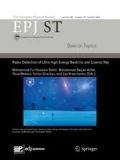Abstract
It is commonly accepted that water plays an essential role in determining both the stability of the 3D structure of protein, as well as speed of the protein folding process. How exactly water does that, is still very controversial. Until recently it was believed that various hydrophobic effects, which originate from the solvent, are the dominant factors. In the first part of this article we discuss the paradigm shift from hydrophobic (HϕO), to a hydrophilic (HϕI) based theory of protein folding. Next, we analyze the types of solvent-induced forces that are exerted on various groups on the protein. We find that the HϕI–HϕI solvent-induced forces are likely to be the strongest. These forces originate from water molecules forming hydrogen-bonded-bridges between two, or more hydrophilic groups attached to the protein. Therefore, it is argued that these forces are also the forces that force the protein to fold, in a short time, along a narrow range of pathways. This paradigm shift brings us, as close as we can hope for, to a solution to the general problem of protein folding.
Similar content being viewed by others
References
Editorial Science 309, 78 (2005)
A. Ben-Naim, the Protein Folding Problem and its Solutions (World Scientific, Singapore, 2013)
C.B. Anfinsen, Science 181, 223 (1973)
C.E. Shannon, Bell Syst. Tech. 27, 379 (1998)
A. Ben-Naim, a Farewell to Entropy. Statistical Mechanics Based on Information (World Scientific, Singapore, 2008)
M.E. Goldberg, TIBS 10, 388 (1985)
G. Kolkata, Science 233, 1037 (1986)
T.E. Creighton, J. Phys. Chem. 89, 2452 (1985)
A. Ben-Naim, Molecular Theory of Water and Aqueous Solutions Part I: Understanding Water (World Scientific, Singapore, 2009)
A. Ben-Naim, Molecular Theory of Water, Aqueous Solutions, Part II, The Role of Water in Protein Folding, Self Assembly and Molecular Recognition (World Scientific, Singapore, 2011)
L. Pauling, The Nature of Chemical Bond, 3rd ed. (Cornell University Press, Ithaca, New York, 1960)
A.E. Mirsky, L. Pauling, Proc. Natl. Acad. Sci. USA 22, 439 (1936)
L. Pauling, R.B. Corey, PNAS USA 37, 235, 251, 272, 729 (1951)
D. Poland, H.A. Scheraga, Theory of Helix-Coil Transition in Biopolymers (New York, 1970)
A. Ben-Naim, Statistical Thermodynamics for Chemists and Biochemists (Plenum Press, New York, 1992)
J.A. Schellman, C. R. Trav. Lab. Carlsberg Ser. Chim. 29, 223 (1955)
W. Kauzmann, Adv. Protein Chem. 14, 1 (1959)
T.E. Creighton, Proteins, Structure and Molecular Principles, Vol. 144 (Freeman: New York, 1984), p. 521
A. Fersht, Structure and Mechanism in Protein Science (W.H. Freeman and Comp, New York, 1999)
J. Schellman, wrote to me that he never felt there was a real conceptual “vacuum”. The HBs were still considered to be important but apparently less important in aqueous media than in vacuum (private communication)
A. Ben-Naim, Molecular Theory of Solutions (Oxford Univ. Press, Oxford, 2006)
C. Tanford, J. Reynolds, Nature’s Robots, A History of Proteins (Oxford University Press, Oxford, 2001)
A. Ben-Naim, Hydrophobic Interactions (Plenum Press, New York, 1980)
A. Ben-Naim, Biopolymers 29, 567 (1990)
A. Ben-Naim, J. Phys. Chem. 95, 1473 (1990)
A. Ben-Naim, J. Chem. Phys. 93, 8196 (1991)
G.D. Rose, P.J. Fleming, J.R. Banavar, A. Maritan, Proc. Natl. Acad. Sci., USA 103, 16623 (2006)
K.A. Dill, Biochemistry 29, 7133 (1990)
E. Haber, C.B. Anfinsen, J. Biol. Chem. 236, 422 (1961)
C. Levinthal, J. Chim. Phys. 65, 44 (1968)
R.M. Sainsbury, Paradoxes (Cambridge University Press, New York, 2009) Sainsbury defines a paradox as follows: “A paradox can be defined as an unacceptable conclusion derived by apparently acceptable reasoning from apparently acceptable premises.” Clearly, the Levinthal paradox is not a paradox according to this definition
R. Zwanzig, A. Szabo, B. Bagchi, Proc. Natl. Acad. Sci., USA 89, 20 (1992)
R. Dawkins, The Blind Watchmaker (Norton, New York, 1987)
J.D. Bryngelson, P.G. Wolynes, Proc. Natl. Acad. Sci. USA 87, 7524 (1987)
P.G. Wolynes, Phil. Trans. Roy. Soc. A 363, 453 (2005)
K.A. Dill, S.B. Ozcan, M.S. Shell, T.R. Weikl, Annu. Rev. Biophys. 37, 289 (2008)
Author information
Authors and Affiliations
Corresponding author
Rights and permissions
About this article
Cite this article
Ben-Naim, A. Water’s contribution in providing strong solvent-induced forces in protein folding. Eur. Phys. J. Spec. Top. 223, 927–946 (2014). https://doi.org/10.1140/epjst/e2013-01981-1
Received:
Revised:
Published:
Issue Date:
DOI: https://doi.org/10.1140/epjst/e2013-01981-1




